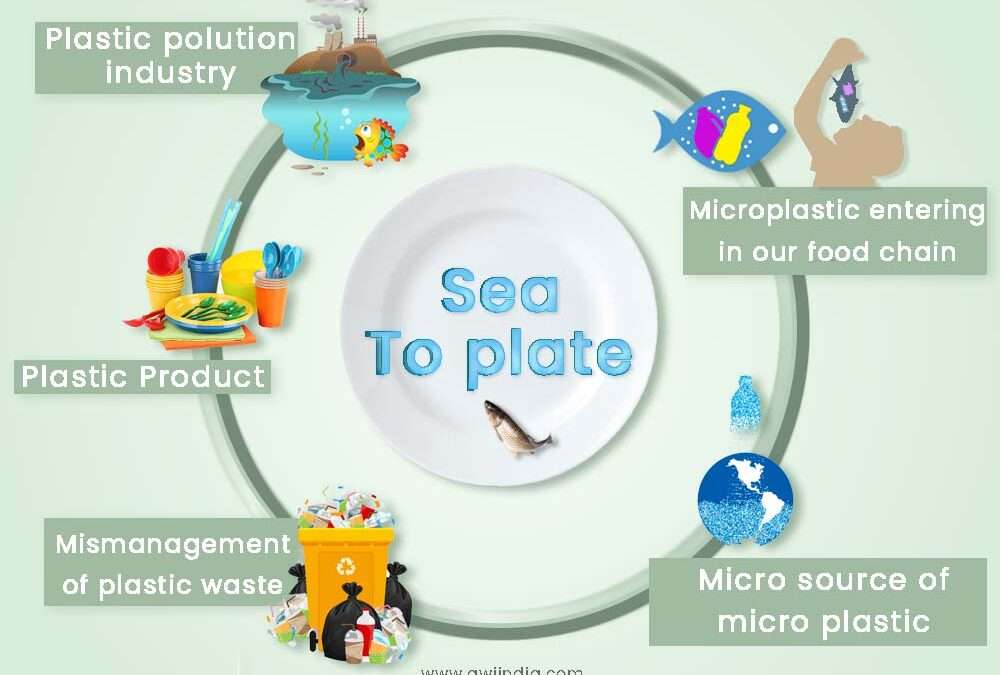We all know that plastic is very harmful to our health as well as environmental health. But we don’t know that microplastic is also harmful. So in this article, we will be going to tell you about what is microplastic. And how microplastic is entering our food chain?
What is microplastic?
Microplastics are tiny plastic flecks that are no larger than 5 millimeters. It has been found in various sources. Including tap water and bottled water, as well as in the air we breathe. It may enter the food chain when infected organisms are consumed. Even, due to plants’ ability to absorb nano plastics through their root systems. It can be detected in fruits and vegetables including apples, broccoli, and carrots.
From Sea to Plate: How Microplastics enter Our Food?
Seafood is a popular and nutritious food source for millions of people worldwide. However, the presence of microplastics in our oceans has raised concerns about the potential contamination of seafood and its impact on human health. Let’s explore how it make their way from the sea to our plates.
- Plastic Pollution in the Oceans: Plastic waste, such as bottles, bags, and packaging materials. It finds its way into our oceans through various sources like improper waste disposal, industrial activities, and coastal runoff. Over time, these plastics break down into smaller fragments.
- Absorption by Marine Organisms: Microplastics in the ocean can be ingested by marine organisms at various levels of the food chain. Filter-feeding animals like mussels, oysters, and clams can directly consume nanoplastics as they filter large volumes of water to extract nutrients. Small fish and plankton may also ingest non-plastics when they mistake them for food.
- Biomagnifications: As larger marine species consume smaller organisms, nano plastics can accumulate in their digestive systems. This process is known as biomagnifications. Predatory fish, such as tuna, salmon, and swordfish, which are often consumed by humans, can accumulate a higher concentration of plastics due to their position higher up in the food chain.
- Human Consumption: When we consume seafood contaminated with microplastics, we inadvertently introduce these particles into our bodies. While the exact health implications of microplastic ingestion are still being researched, studies suggest that microplastics could potentially lead to adverse effects on human health, such as inflammation, tissue damage, and the release of harmful chemicals.
- Controlling plastic Contamination: Efforts are being made to mitigate plastic pollution and reduce the presence of microplastics in our oceans. Governments and organizations are implementing measures like improved waste management, recycling initiatives, and regulations on single-use plastics to limit their environmental impact.
Overall, microplastics have the ability to absorb and accumulate toxic chemicals, such as persistent organic pollutants. The combination of physical and chemical hazards associated with it calls for urgent action to mitigate their presence and prevent further contamination of our food chain.
Addressing the issue requires a multi-faceted approach. Efforts should focus on reducing plastic waste, promoting recycling, and developing biodegradable alternatives to plastics. Additionally, improved waste management systems, including filtration technologies, can help prevent the release of plastics into the environment.
To safeguard the health of both ecosystems and humans, It is crucial to raise awareness, support further scientific research, and implement effective policies and practices that aim to minimize the entry of plastics into our food chain. Only through collective action can we mitigate the risks associated with microplastics and ensure a healthier and more sustainable future.


